Portal:Cannabis
From Wikipedia, the free encyclopedia
Jump to navigation
Jump to search
Wikipedia's portal for exploring content related to Cannabis
 |
Portal maintenance status: (August 2018)
- This portal has a single page layout. Any subpages are likely no longer needed.
Please take care when editing, especially if using automated editing software.
|
- Portal topics
- Activities
- Culture
- Geography
- Health
- History
- Mathematics
- Nature
- People
- Philosophy
- Religion
- Society
- Technology
- Random portal
.mw-parser-output .portal-banner-image imgdisplay:block;width:100%;height:auto.mw-parser-output .portal-banner-image .mw-gallery-slideshow-buttonsposition:absolute;width:100%;z-index:1000

Cannabis sativa
Cannabis () is a genus of flowering plants in the family Cannabaceae. The number of species within the genus is disputed. Three species may be recognized: Cannabis sativa, Cannabis indica, and Cannabis ruderalis; C. ruderalis may be included within C. sativa; or all three may be treated as subspecies of a single species, C. sativa. The genus is widely accepted as being indigenous to and originating from Central Asia, with some researchers also including upper South Asia in its origin.
The plant is also known as hemp, although this term is often used to refer only to varieties of Cannabis cultivated for non-drug use. Cannabis has long been used for hemp fibre, for hemp oils, for medicinal purposes, and as a recreational drug. Industrial hemp products are made from cannabis plants selected to produce an abundance of fiber. To satisfy the UN Narcotics Convention, some cannabis strains have been bred to produce minimal levels of tetrahydrocannabinol (THC), the principal psychoactive constituent. Many plants have been selectively bred to produce a maximum of THC (cannabinoids), which is obtained by curing the flowers. Various compounds, including hashish and hash oil, are extracted from the plant.
Read more...
Refresh with new selections below (purge)
.mw-parser-output .flex-columns-containerclear:both;width:100%;display:flex;flex-wrap:wrap.mw-parser-output .flex-columns-container>.flex-columns-columnfloat:left;width:50%;min-width:360px;padding:0 0.5em;box-sizing:border-box;flex:1;display:flex;flex-direction:column.mw-parser-output .flex-columns-container>.flex-columns-column:first-childpadding-left:0.mw-parser-output .flex-columns-container>.flex-columns-column:last-childpadding-right:0@media screen and (max-width:720px).mw-parser-output .flex-columns-container>.flex-columns-columnpadding:0;width:100%.mw-parser-output .flex-columns-container>.flex-columns-column>divflex:1 0 auto.mw-parser-output .flex-columns-container>.flex-columns-column>div.flex-columns-noflexflex:0
Selected general articles
.mw-parser-output div.excerptSlideshow-container>ul.gallery.mw-gallery-slideshow>li.gallerycarousel>div>div>div>span:nth-child(2)display:none.mw-parser-output div.excerptSlideshow-container>ul.gallery.mw-gallery-slideshow>li.gallerycarousel>div>div:nth-child(2)display:none.mw-parser-output div.excerptSlideshow-container>ul.gallery.mw-gallery-slideshow>li.gallerycarousel>div>div:nth-child(1)padding-bottom:0.mw-parser-output div.excerptSlideshow-container>ul.gallery.mw-gallery-slideshow>li:nth-child(n/**/+2)display:none.mw-parser-output div.excerptSlideshow-container .gallery .gallerybox,.mw-parser-output div.excerptSlideshow-container .gallery .gallerybox divwidth:100%!important;max-width:100%.mw-parser-output div.excerptSlideshow-container>ul.gallery.mw-gallery-slideshow>li:not(.gallerycarousel)>div>div:nth-child(1)display:none
Cannabis tea (also known as herbal tea, weed tea, pot tea, ganja tea, or green tea) is a cannabis-infused drink made with cannabis infused in hot or cold water. Properly produced decarboxylated cannabis teas are very effective when ingested. Read more...

World map of annual cannabis prevalence
This is a list of the annual prevalence of
cannabis use by country (including some territories) as a percentage of the population aged 15–64 (unless otherwise indicated). The indicator is an "annual prevalence" rate which is the percentage of the youth and adult population who have consumed cannabis at least once in the past survey year.
Read more...
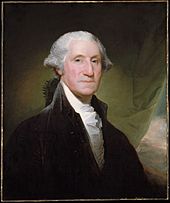
First President of the United States George Washington, one of the Founding Fathers known to have grown hemp prior to prohibition
is a plant and, as hemp, a source for fibers, oil, and seed. Prior to its prohibition, U.S. politicians known for growing hemp include some of the nation's Founding Fathers and presidents. Politicians who have admitted to recreational use of the drug during prohibition include mayors, governors, members of the House of Representatives, Senators and presidents.
Read more...

Marc and Jodie Emery, former publisher and editor
is a Canadian online magazine and former print magazine devoted to cannabis and the worldwide cannabis subculture.
Cannabis Culture publishes stories about the struggle to legalize marijuana, profiles of marijuana paraphernalia, articles on how to grow marijuana, interviews with prominent marijuana users, and coverage of cannabis cultural events like the Nimbin MardiGrass festival and the
High Times Cannabis Cup.
Read more...
Cannabis flower essential oil, also known as
hemp essential oil, is an essential oil obtained by steam distillation from the flowers and upper leaves of the hemp plant (Cannabis sativa L.) Hemp essential oil is distinct from hemp seed oil, hemp oil and hash oil: the former is a vegetable oil that is pressed from the seeds of low-THC varieties of hemp, the latter is a THC-rich extract of dried female hemp flowers (marijuana) or resin (hashish).
A pale yellow liquid, cannabis flower essential oil is a volatile oil that is a mixture of monoterpenes, sesquiterpenes, and other terpenoid compounds. The typical scent of hemp results from about 140 different terpenoids. The essential oil is manufactured from both low-THC ("fibre-type") and high-THC ("drug-type") varieties of hemp. As most of the phytocannabinoids are nearly insoluble in water, hemp essential oil contains only traces of cannabinoids. Even in "drug-type" hemp, the THC content of the essential oil does not exceed 0.08%.
Hemp essential oil is used as a scent in perfumes, cosmetics, soaps, and candles. It is also used as a flavoring in foods, primarily candy and beverages.
Read more...
Cannabis use disorder (CUD), also known as cannabis addiction or marijuana addiction, is defined in the fifth revision of the Diagnostic and Statistical Manual of Mental Disorders (DSM-5) and ICD-10 published by World Health Organization as the continued use of cannabis despite clinically significant impairment, ranging from mild to severe. Read more...
The history of medical cannabis goes back to ancient times. Ancient physicians in many parts of the world mixed cannabis into medicines to treat pain and other ailments. In the 19th century, cannabis was introduced for therapeutic use in Western Medicine. Since then, there have been several advancements in how the drug is administered. Initially, cannabis was reduced to a powder and mixed with wine for administration. In the 1970's, synthetic THC was created to be administered as the drug Marinol in a capsule. However, the main mode of administration for cannabis is smoking because its effects are almost immediate when the smoke is inhaled. Between 1996 and 1999, eight U.S. states supported cannabis prescriptions opposing policies of the federal government. Most people who are prescribed marijuana for medical purposes use it to alleviate severe pain. Read more...
The Marijuana Policy Project (MPP) is the largest organization working solely on marijuana policy reform in the United States in terms of its budget, number of members, and staff. Its stated aims are to: (1) increase public support for non-punitive, non-coercive marijuana policies; (2) identify and activate supporters of non-punitive, non-coercive marijuana policies; (3) change state laws to reduce or eliminate penalties for the medical and non-medical use of marijuana; and (4) gain influence in Congress. MPP advocates taxing and regulating the possession and sale of marijuana in a manner similar to alcohol, envisions a nation where marijuana education is honest and realistic, and believes treatment for problem marijuana users should be non-coercive and geared toward reducing harm. Read more...
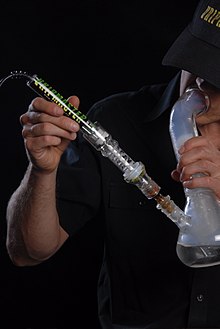
A vaporization heat wand and vaporization chamber bowl used to deliver vapor through a water pipe
A
vaporizer or
vaporiser, colloquially known as a
vape, is a device used to vaporize substances for inhalation. Plant substances can be used, commonly cannabis, tobacco, or other herbs or blends. However, they can also be filled with a mixture of propylene glycol, glycerin, and drugs such as nicotine (e.g. tobacco-free nicotine) or tetrahydrocannabinol.
Vaporizers contain various forms of extraction chambers including straight bore, venturi, or sequential venturi, and are made of materials such as metal or glass. The extracted vapor may be collected in an inflatable bag, or inhaled directly through a hose or pipe. When used properly, cooler temperatures due to lack of combustion result in significantly more efficient extraction of the ingredients. Hence, the irritating and harmful effects of smoking are heavily reduced, as is its secondhand smoke.
Read more...

Sebsi, a Moroccan long-drawtube one-hitter.
is the inhalation of smoke or vapors released by heating the flowers, leaves, or extracts of cannabis and releasing the main psychoactive chemical, Δ
9-tetrahydrocannabinol (THC), which is absorbed into the bloodstream via the lungs.
Apart from being smoked and vaporized, cannabis (and its active cannabinoids) may be ingested, placed under the tongue or applied to the skin. The bioavailability characteristics and effects of smoking and vaporizing cannabis differ from other consumption methods in having a more rapid and predictable onset of effect.
Read more...
The Coalition for Rescheduling Cannabis is a U.S. organization founded c. 2002 to support removal of marijuana from Schedule I of the Controlled Substances Act. The group was organized immediately after the U.S. Court of Appeals denied the High Times/Jon Gettman petition to reschedule cannabis, ruling that the petitioners were not sufficiently injured to have standing to challenge the Drug Enforcement Administration's interpretation of the scientific record in federal court. On October 8, 2002, the Coalition filed a new petition to have cannabis rescheduled under federal law.
The Coalition has recently filed a Petition for Writ of Mandamus. Carl Olsen of Iowans for Medical Marijuana, a former Coalition member, has filed a motion to intervene.
The organizations comprising the Coalition are: Read more...
World laws on possession of small amounts of cannabis for personal use.
<span class="legend-color" style="display:inline-block; width:1.5em; height:1.5em; margin:1px 0; border:1px solid black; background-color:
The Finnish Cannabis Association (FCA; Finnish: Suomen kannabisyhdistys; Swedish: Finlands Cannabisförening, commonly referred to by the acronym SKY) is a Finnish non-governmental organisation whose purpose is to advocate legalisation or decriminalisation of cannabis.
The FCA started operating in 1990 and was officially established in 1991. According its mission statement, the purpose of the association is to influence the Finnish legislation so that adults could legally use, obtain and cultivate cannabis for personal use. The FCA also studies the use of cannabis in different cultures during different times.
The association had 36 members in 1991, and about 650 in 2000. Read more...

The bracts surrounding a cluster of Cannabis sativa flowers are coated with cannabinoid-laden trichomes
The Marijuana Control, Regulation, and Education Act, also known as California Assembly Bill 390 (A.B. 390) and later Assembly Bill 2254 (A.B. 2254), is the first bill ever introduced to regulate the sale and use of marijuana in the U.S. state of California. If passed and signed into law, marijuana would be sold and taxed openly to adults age 21 and older in California. Tom Ammiano, a Democrat representing California's 13th State Assembly district, introduced this piece of legislation on February 23, 2009, arguing that the bill will "tax and regulate marijuana in a manner similar to alcohol." As introduced, this proposal is estimated to raise over $1 billion in annual revenue by taxing the retail production and sale of marijuana for adults 21 years of age and older. To obtain a commercial grow license one would pay an initial $5,000 fee, then a $2,500 fee each year after that. A tariff of $50 per ounce would also be placed on all sold and grown marijuana. The bill has gained much media attention, statewide and nationally.
The bill was not approved by the Health Committee before a January 15 deadline, effectively killing the bill until it was reintroduced in 2010 as A.B. 2254 and the process continued.
Recent polls say 56% of Californians favor taxing and regulating marijuana. In November 2010, the failed Proposition 19 was posed to Californian voters, and would have effectively made possession and cultivation of marijuana legal for citizens over the age of 21. The bill was reintroduced as Marijuana Control and Regulation Act of 2010 in slightly different form as Assembly Bill x6 9 Read more...
A cannabis edible, also known as a cannabis-infused food or simply an edible, is a food product that contains cannabinoids, especially tetrahydrocannabinol (THC). Although edible may refer to either a food or a drink, a cannabis-infused drink may be referred to specifically as a liquid edible or drinkable.
Most edibles contain a significant amount of THC, which can induce a wide range of effects, including relaxation, euphoria, increased appetite, fatigue, and anxiety. THC-dominant edibles are consumed for recreational and medical purposes. Some edibles contain a negligible amount of THC and are instead dominant in other cannabinoids, most commonly cannabidiol (CBD). These edibles are primarily used for medical purposes only.
Foods and beverages made from non-psychoactive cannabis products are known as hemp foods. Read more...
The Hanfparade (English: Hemp Parade) is a hemp legalization demonstration in Berlin. It has taken place each year in August since 1997.
The traditional course of the parade floats make a prelude through the German capital. In a demonstration, thousands give hemp and cannabis their attention. At the end of the demonstration a closing speech takes place.
The parade offers a variety of hemp-related entertainment. The main stage offers mixes of speeches and live-music. National and international musicians entertain the visitors, which often includes high-ranking personalities from politics, culture, medicine and the legalization movement. In the speakers corner an open microphone waits for contributions. Read more...
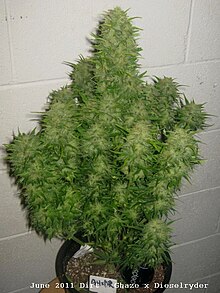
GHaze x Dieselryder autoflower
varieties automatically switch from vegetative growth to the flowering stage with age, as opposed to the ratio of light to dark hours required with photoperiod dependent/short-day strains. Many autoflowers will be ready to harvest in less than 10 weeks from seed. Dwarf varieties can have short stature while still giving decent yield. Conversely "super autos" can take over 100 days to mature and can reach over 6 feet tall.
Read more...
In the United States, the non-medical use of cannabis is decriminalized in 13 states (plus the U.S. Virgin Islands), and legalized in another 9 states (plus the District of Columbia), as of January 2018. "Decriminalization" refers to a policy in which individuals caught possessing small amounts of cannabis will not face criminal prosecution, and instead will be subject to only some type of lesser civil penalty (often similar to how a minor traffic violation is treated). In jurisdictions without any such penalties, the policy is referred to as legalization, although the term decriminalization is sometimes broadly used for this purpose as well.
The first state to decriminalize cannabis was Oregon in 1973. Ten more states followed during the 1970s, influenced by the federally-appointed Shafer Commission which endorsed the policy of decriminalization. By the end of the decade the tide had turned strongly in the other direction, however, and no state would decriminalize again until 2001.
In 2012 Colorado and Washington became the first states to legalize cannabis, both by way of ballot initiative. Several states followed in 2014 and 2016, and in 2018 Vermont became the first to legalize through an act of state legislature. All jurisdictions that have legalized cannabis allow for its commercial distribution, except Vermont and the District of Columbia. All allow for personal cultivation, except Washington state. Read more...
Cannabinoids present in the cannabis plant and its derived drugs are known to cause impaired driving in users, with effects on a driver similar to those of alcohol. Meta-analysis of epidemiological studies shows that recent cannabis use elevates the risk of motor vehicle accident 1.5 to 2 times above control. Many jurisdictions have laws forbidding cannabis-impaired driving, and some have per se impairment levels determined by metabolites detected in body fluids. Read more...

Hemp hurds can be used for animal bedding
Hemp fiber, seed and oil can be
used for a number of products.
;Food products
*Hemp juice
*Hemp milk
*Hemp protein
*Maltos-Cannabis
;Construction and materials
*Fiber reinforced plastic
*Hempcrete
*Oakum
Read more...
Cannabis consumption in pregnancy might be associated with restrictions in growth of the fetus, miscarriage, and cognitive deficits. The American Congress of Obstetricians and Gynecologists recommended that cannabis use be stopped before and during pregnancy, Cannabis is the most commonly used illicit substance
among pregnant women.
Although it is difficult to draw firm conclusions, there is some evidence that prenatal exposure to marijuana may be associated with deficits in language, attention, cognitive performance, and delinquent behaviors. THC exposure in rats during the prenatal developmental phase may cause epigenetic changes in gene expression, but there is limited knowledge about the risk for psychiatric disorders because of ethical barriers to studying the developing human brain. While animal studies cannot take into account factors that could influence the effects of cannabis on human maternal exposure, such as environmental and social factors, a 2011 review of rodent studies by Campolongo et al. said there was "... increasing evidence from animal studies showing that cannabinoid drugs ... induce enduring neurobehavioral abnormalities in the exposed offspring ..." Campolongo et al. added that "clinical studies report hyperactivity, cognitive impairments and altered emotionality in humans exposed in utero to cannabis". Martin et al. investigated recent trends in substance abuse treatment admissions for cannabis use in pregnancy in the US, based on Treatment Episodes Data Set (TEDS) from 1992 to 2012, and discovered that, while the proportion of treatment admissions for pregnant women was stable (about 4%), the admissions for women who were pregnant and reported any marijuana use grew from 29% to 43%. A 2015 review found that cannabis use by pregnant mothers impaired brain maturation in their children, and that it also predisposed their children to neurodevelopmental disorders. Read more...
Safer Alternative For Enjoyable Recreation (SAFER) is a non-profit organization based in Denver, Colorado. The SAFER campaign was initially launched in Colorado on the campuses of the University of Colorado at Boulder (CU) and Colorado State University (CSU) in response to the alcohol overdose deaths of CSU sophomore Samantha Spady, 19, and 18-year-old CU freshman Lynn "Gordie" Bailey. SAFER, led by Mason Tvert, argued that students should not be punished more severely for using marijuana – which is incapable of causing death by overdose—than for using the potentially fatal (and for many college students legal) drug alcohol.
The pilot project took off quickly. Within months, organizers had coordinated and passed student referendums at both campuses. These referendums called on the universities to make the penalties for the use and possession of marijuana no greater than the penalties for the use and possession of alcohol.
Under Colorado state law prior to 2013, having an ounce of marijuana or less is punishable by a $100 fine but no jail time.
In the summer of 2005, SAFER leaders decided to run a citywide marijuana legalization initiative in Denver, Colorado called the Alcohol-Marijuana Equalization Initiative. The proposed initiative (I-100) would have made the possession of up to one ounce of marijuana legal for individuals 21 and older under city ordinances. After a campaign in which the relative harms of marijuana and alcohol were repeatedly highlighted, the initiative passed November 1, 2005 by a 53.5% to 46.5% margin. The initiative also made possession of marijuana by those under 18 punishable by fine only. Read more...
The removal of cannabis from Schedule I of the Controlled Substances Act, the most tightly restricted category reserved for drugs that have "no currently accepted medical use," has been proposed repeatedly since 1972.
Rescheduling proponents argue that cannabis does not meet the Controlled Substances Act's strict criteria for placement in Schedule I and so the government is required by law to permit medical use or to remove the drug from federal control altogether. The US government, on the other hand, maintains that cannabis is dangerous enough to merit Schedule I status. The dispute is based on differing views on both how the Act should be interpreted and what kinds of scientific evidence are most relevant to the rescheduling decision.
The Act provides a process for rescheduling controlled substances by petitioning the Drug Enforcement Administration. The first petition under this process was filed in 1972 to allow cannabis to be legally prescribed by physicians. The petition was ultimately denied after 22 years of court challenges, but a synthetic pill form of cannabis's psychoactive ingredient, THC, was rescheduled in 1986 to allow prescription under schedule II. In 1999, it was again rescheduled to allow prescription under schedule III. Read more...
Different religions have varying stances on the use of cannabis, historically and presently. In ancient history some religions used cannabis as an entheogenic, particularly in South Asia where the tradition continues on a more limited basis.
In the modern era, religions with prohibitions against intoxicants, such as Islam, Buddhism, Bahai, Latter-day Saints (Mormons), and others have opposed the use of cannabis by members, or in some cases opposed the liberalization of cannabis laws. Other groups, such as some Protestant and Jewish factions, have supported the use of medicinal cannabis. Read more...

The "Nirvana" head shop in Dublin, Ireland. A large image of a cannabis leaf adorns the front of the store.
A
head shop is a retail outlet specializing in paraphernalia used for consumption of cannabis and tobacco and items related to cannabis culture and related countercultures. Products may include magazines (e.g., about cannabis culture, cannabis cultivation, tattooing and music), clothing, and home décor (e.g., posters and wall hangings illustrating drug culture themes such as cannabis, jam bands like The Grateful Dead, psychedelic art, etc.). Some head shops also sell oddities, such as antique walking sticks and sex toys. Since the 1980s, some head shops have sold clothing related to the heavy metal or punk subculture, such as band T-shirts and cloth patches with band logos, studded wristbands, bullet belts and leather boots. Head shops emerged from the hippie counterculture in the late 1960s, and many of them had close ties to the anti-Vietnam War movement as well as groups in the marijuana legalization movement like LeMar, Amorphia, and the National Organization for the Reform of Marijuana Laws.
Products offered typically include hashish pipes, "one hitter" pipes; pipe screens; bongs (also referred to as water pipes); roach clips (used for smoking the end of a marijuana "joint"); vaporizers used for inhaling THC vapour from cannabis; rolling papers; rolling machines; small weighing scales; small ziplock baggies; cannabis grinders; blacklight-responsive posters and blacklights; incense; cigarette lighters; "stashes", which include a range of standard consumer products such as clocks, books, tins of cleaning powder and toilet brushes which have hidden compartments for cannabis and non-camouflaged "stash boxes" which are tins or wooden containers for storing marijuana; and legal highs such as whipped-cream chargers (which contain nitrous oxide) and
Salvia divinorum (both of which are illegal in some countries and some US states for recreational purposes). Some head shops also sell items used for home cultivation of marijuana plants, such as hydroponic equipment and lights and guidebooks on cultivation. Since the 2000s, some head shops also sell e-cigarettes and the flavoured liquids used with these devices.
Read more...

Madrid, Spain. May 8, 2004. Million Joint March (La Marcha del Millón de Porros en Madrid, Mayo 2004), part of the Million Marijuana March.
The
Global Marijuana March (
GMM), also referred to as the
Million Marijuana March (
MMM), is an annual rally held at different locations around the world on the first Saturday in May. A notable event in cannabis culture, it is associated with cannabis-themed events, which may include marches, meetings, rallies, raves, concerts, festivals, and attempts at educational outreach.
The first Global Marijuana March was held in 1999. Since then, hundreds of thousands of people have participated in over 829 different cities in 72 countries. Locally, the Global Marijuana March is associated with names including World Cannabis Day, Cannabis Liberation Day, Global Space Odyssey, Ganja Day, J Day, and Million Blunts March.
Read more...
Kyllo v. United States, 533 U.S. 27 (2001), held in a 5–4 decision that the use of a thermal imaging, or FLIR, device from a public vantage point to monitor the radiation of heat from a person's home was a "search" within the meaning of the Fourth Amendment, and thus required a warrant. Read more...

Bag and contents of a well known early brand named Spice that contains herbs spiked with synthetic cannabinoids, now illegal throughout much of the world
are a class of molecules that bind to cannabinoid receptors in the body—the same receptors to which THC and CBD attach–which are cannabinoids in cannabis plants. Synthetic cannabinoids are also designer drugs that are often sprayed onto plant matter. They are typically consumed through smoking, although more recently they have been consumed in a concentrated liquid form in the US and UK. They have been marketed as herbal incense, or “herbal smoking blends” and sold under common names like K2, Spice, and Synthetic Marijuana. They are also often labeled “not for human consumption.”
When synthetic cannabinoid blends first went on sale in the early 2000s, it was thought that they achieved the psychoactive effects through a mixture of natural herbs. Laboratory analysis in 2008 showed that this was not the case, and that many in fact contained synthetic cannabinoids. Today, synthetic cannabinoids are the most common new psychoactive substances to be reported. From 2008 to 2014, 142 synthetic cannabinoids were reported to the European Monitoring Centre for Drugs and Drug Addiction (EMCDDA). A large and complex variety of synthetic cannabinoids are designed in an attempt to avoid the legal restrictions on cannabis, making synthetic cannabinoids designer drugs.
Most synthetic cannabinoids are agonists of the cannabinoid receptors, and many have been designed based on THC, the natural cannabinoid with the strongest binding affinity to the CB
1 receptor, which is linked to the psychoactive effects or “high” of marijuana. These synthetic analogs often have greater binding affinity and greater potency to the CB
1 receptors. There are several synthetic cannabinoid families (e.g. CP-xxx, WIN-xxx, JWH-xxx, UR-xxx, and PB-xx) classified based on the base structure.
Read more...
The Hemp Industries Association (HIA) is a non-profit trade group representing hemp companies, researchers and supporters in the United States and Canada. The group petitions for fair and equal treatment of industrial hemp. Since 1992, the HIA has been dedicated to education, industry development, and the accelerated expansion of hemp world market supply and demand.
The HIA was founded by cannabis activist and author Chris Conrad, who also served as the organization's first president.
In 2010, the organization bought the diaries of Lyster Dewey and plans to display them to the public for the first time in many years. Read more...
The American Medical Marijuana Association (AMMA) is an organization formed to promote and protect the legal access to medical marijuana.
The American Medical Marijuana Association (AMMA), was founded in cyberspace on October 27, 2000, by Steve Kubby, Ed Rosenthal and Tod H. Mikuriya. AMMA has been at the forefront of the battle to protect the rights of medical cannabis patients and recently received official recognition by the United States government as one of the top organization websites promoting medical marijuana law reform. This recommendation appears in a briefing by the White House and is available online at the official web site for the White House Drug Policy.
AMMA is a group of volunteers working together to implement, preserve and protect the rights of medicinal cannabis patients through political activism. Their platform is based on the idea of not bargaining away people's rights. AMMA believes that each person will have different needs, which are best determined by the patient and physician. What works well for one patient may not work for another. Read more...
Leary v. United States, 395 U.S. 6 (1969), is a U.S. Supreme Court case dealing with the constitutionality of the Marihuana Tax Act of 1937. Timothy Leary, a professor and activist, was arrested for the possession of marijuana in violation of the Marihuana Tax Act. Leary challenged the act on the ground that the act required self-incrimination, which violated the Fifth Amendment. The unanimous opinion of the court was penned by Justice John Marshall Harlan II and declared the Marihuana Tax Act unconstitutional. Thus, Leary's conviction was overturned. Congress responded shortly thereafter by replacing the Marihuana Tax Act with the newly written Controlled Substances Act while continuing the prohibition of certain drugs in the United States. Read more...
The
National Organization for the Reform of Marijuana Laws (
NORML ( listen)
listen)) is an American non-profit organization based in Washington, DC whose aim is to move public opinion sufficiently to achieve the legalization of non-medical marijuana in the United States so that the responsible use of cannabis by adults is no longer subject to penalty. According to their website, NORML "supports the removal of all criminal penalties for the private possession and responsible use of marijuana by adults, including the cultivation for personal use, and the casual nonprofit transfers of small amounts", and "supports the development of a legally controlled market for cannabis". NORML and the
NORML Foundation support both those fighting prosecution under marijuana laws and those working to legalize marijuana. Similar affiliated organizations operate under the NORML banner in other countries, among them NORML New Zealand, NORML Ireland, NORML Canada, NORML UK and NORML France.
In the 2006 United States midterm elections, NORML promoted several successful local initiatives that declared marijuana enforcement to be the lowest priority for local law enforcement, freeing up police resources to combat violent and serious crime.
Read more...
Cannabis drug testing describes various drug test methodologies for the use of cannabis in medicine, sport, and law. Cannabis use is highly detectable and can be detected by urinalysis, hair analysis, as well as saliva tests for days or weeks.
Unlike alcohol, for which impairment can be reasonably measured using a breathalyser (and confirmed with a blood alcohol content measurement), valid detection for cannabis is time-consuming, and tests cannot determine an approximate degree of impairment. The lack of suitable tests and agreed-upon intoxication levels is an issue in the legality of cannabis debate, especially regarding intoxicated driving.
The concentrations obtained from such analyses can often be helpful in distinguishing active use from passive exposure, elapsed time since use, and extent or duration of use. Read more...
Terms related to cannabis include:
Read more...
The list includes significant events globally in the history of national-level cannabis law. Read more...
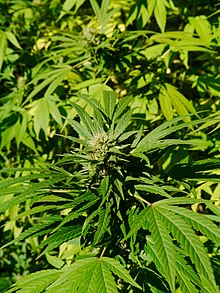
Cannabis sativa female- recreational/medicinal marijuana, not hemp
is an annual herbaceous flowering plant indigenous to eastern Asia but now of cosmopolitan distribution due to widespread cultivation. It has been cultivated throughout recorded history, used as a source of industrial fiber, seed oil, food, recreation, religious and spiritual moods and medicine. Each part of the plant is harvested differently, depending on the purpose of its use. The species was first classified by Carl Linnaeus in 1753.
Read more...
Cannabis is legal in
Uruguay, and is one of the most widely used drugs in the nation.
President Jose Mujica signed legislation to legalize recreational cannabis in December 2013, making Uruguay the first country in the modern era to legalize cannabis. In August 2014, Uruguay legalized growing up to six plants at home, as well as the formation of growing clubs, a state-controlled marijuana dispensary regime, and the creation of a Cannabis regulatory institute (IRCCA in Spanish). In October 2014 the Government began registering growers' clubs, allowed in turn to grow a maximum of 99 cannabis plants annually; as of August 2015, there were 2,743 registered personal growers. After a long delay in implementing the retail component of the law, in 2017 sixteen pharmacies were authorized to sell cannabis commercially.
Read more...
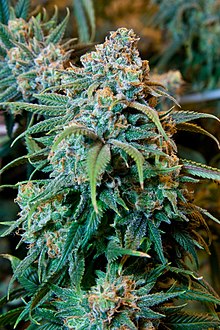
A flowering cannabis plant
, also known as
marijuana among other names, is a psychoactive drug from the
Cannabis plant used for medical or recreational purposes. The main psychoactive part of cannabis is tetrahydrocannabinol (THC), one of 483 known compounds in the plant, including at least 65 other cannabinoids. Cannabis can be used by smoking, vaporizing, within food, or as an extract.
Cannabis is often used for its mental and physical effects, such as a "high" or "stoned" feeling, a general change in perception, heightened mood, and an increase in appetite. Onset of effects is within minutes when smoked, and about 30 to 60 minutes when cooked and eaten. They last for between two and six hours. Short-term side effects may include a decrease in short-term memory, dry mouth, impaired motor skills, red eyes, and feelings of paranoia or anxiety. Long-term side effects may include addiction, decreased mental ability in those who started as teenagers, and behavioral problems in children whose mothers used cannabis during pregnancy. Studies have found a strong relation between cannabis use and the risk of psychosis, though the cause-and-effect relationship is debated.
Cannabis is mostly used recreationally or as a medicinal drug, although it may also be used for spiritual purposes. In 2013, between 128 and 232 million people used cannabis (2.7% to 4.9% of the global population between the ages of 15 and 65). In 2015, 43% of Americans had ever used cannabis, which increased to 51% in 2016. About 12% have used it in the past year, and 7.3% have used it in the past month. This makes it the most commonly used illegal drug both in the world and the United States.
Read more...
The plant name Cannabis is from Greek κάνναβις (kánnabis), via Latin cannabis, originally a Scythian or Thracian word, also loaned into Persian as kanab. English hemp (Old English hænep) may be an early loan (predating Grimm's Law) from the same Scythian source. Read more...
Marijuana Anonymous (MA) is an organization and twelve-step program for people with common desire to maintain abstinence from marijuana. Read more...
Legal status of recreational cannabis across the world----
<span class="legend-color" style="display:inline-block; width:1.5em; height:1.5em; margin:1px 0; border:1px solid black; background-color:
Americans for Safe Access (
ASA), based in Washington, D.C., is a member-based organization working to ensure safe and legal access to cannabis for therapeutic uses and research. Americans for Safe Access works in partnership with local, state, and federal legislators to create policies that improve access to medical cannabis for both patients and researchers. ASA has over 100,000 active members across the United States.
Read more...
Cannabis Law Reform (CLEAR), formerly the Legalise Cannabis Alliance, is a UK lobby group which campaigns to end the prohibition of cannabis, most urgently for those who need it as medicine. Read more...
Cannabis ruderalis is a low-THC species of
Cannabis which is native to Central and Eastern Europe and Russia. Many scholars accept
Cannabis ruderalis as its own species due to its unique traits and phenotypes which distinguish it from
Cannabis indica and
Cannabis sativa, however it is widely debated as to whether or not
ruderalis is a sub-species of
Cannabis sativa.
Read more...
Hemp for Victory is a black-and-white United States government film made during World War II and released in 1942, explaining the uses of hemp, encouraging farmers to grow as much as possible. During World War II, the Marihuana Tax Act of 1937 was lifted briefly to allow for hemp fiber production to create ropes for the U.S. Navy but after the war hemp reverted to its de facto illegal status.
Read more...
The endocannabinoid system (ECS) is a biological system composed of endocannabinoids, which are endogenous lipid-based retrograde neurotransmitters that bind to cannabinoid receptors, and cannabinoid receptor proteins that are expressed throughout the mammalian central nervous system (including the brain) and peripheral nervous system. The endocannabinoid system is involved in regulating a variety of physiological and cognitive processes including fertility, pregnancy, during pre- and postnatal development, appetite, pain-sensation, mood, and memory, and in mediating the pharmacological effects of cannabis. The ECS is also involved in mediating some of the physiological and cognitive effects of voluntary physical exercise in humans and other animals, such as contributing to exercise-induced euphoria as well as modulating locomotor activity and motivational salience for rewards. In humans, the plasma concentration of certain endocannabinoids (i.e., anandamide) have been found to rise during physical activity; since endocannabinoids can effectively penetrate the blood–brain barrier, it has been suggested that anandamide, along with other euphoriant neurochemicals, contributes to the development of exercise-induced euphoria in humans, a state colloquially referred to as a runner's high.
Two primary endocannabinoid receptors have been identified: CB1, first cloned in 1990; and CB2, cloned in 1993. CB1 receptors are found predominantly in the brain and nervous system, as well as in peripheral organs and tissues, and are the main molecular target of the endocannabinoid ligand (binding molecule), anandamide, as well as its mimetic phytocannabinoid, THC. One other main endocannabinoid is 2-arachidonoylglycerol (2-AG) which is active at both cannabinoid receptors, along with its own mimetic phytocannabinoid, CBD. 2-AG and CBD are involved in the regulation of appetite, immune system functions and pain management. Read more...

A
sadhu, or holy person, smoking cannabis in Kolkata, India
Cannabis has been used in an entheogenic context—a chemical substance used in a religious, shamanic, or spiritual context—in India and Nepal since the Vedic period dating back to approximately 1500 BCE, but perhaps as far back as 2000 BCE. Cannabis has been used by shamanic and pagan cultures to ponder deeply religious and philosophical subjects related to their tribe or society, to achieve a form of enlightenment, to unravel unknown facts and realms of the human mind and subconscious, and also as an aphrodisiac during rituals or orgies. There are several references in Greek mythology to a powerful drug that eliminated anguish and sorrow. Herodotus wrote about early ceremonial practices by the Scythians, thought to have occurred from the 5th to 2nd century BCE. Itinerant Hindu saints have used it in Nepal and India for centuries. Over the last few decades hundreds of archaeological and anthropological items of evidence have come out of Mexican, Mayan and Aztec cultures that suggest cannabis, along with magic mushrooms (psilocybin), peyote (mescaline) and other psychoactive plants were used in cultural shamanic and religious rituals. Mexican-Indian communities occasionally use cannabis in religious ceremonies by leaving bundles of it on church altars to be consumed by the attendees.
Read more...
High Times is a New York–based monthly magazine founded in 1974 by Tom Forçade. The publication advocates the legalization of cannabis. The magazine has been involved in the marijuana-using counterculture since its inception. Read more...
- ... that according to his memoirs, Howard Marks concluded a drug deal at the Warwick Castle with half a consignment of Thai grass hidden in a car parked outside?
- ... that the Whakamana Cannabis Museum, New Zealand's first museum dedicated to cannabis culture, opened in Caversham, Dunedin, in 2013?
- ... that the Northwest Cannabis Solutions Satsop facility is operated by the largest grower of legal cannabis in the U.S. state of Washington at the site of a canceled nuclear power plant?
- ... that last month, four members of the U.S. House of Representatives formed the Congressional Cannabis Caucus?
- ... that while in the Legislative Assembly of the Federal District, Vidal Llerenas Morales presented initiatives supporting the legalization of marijuana?
- ... that after retiring from the Kentucky Supreme Court, Dan Jack Combs was twice arrested on marijuana-related charges and became an advocate for the drug's legalization in the United States?
Do you have a question about Cannabis that you can't find the answer to?
Consider asking it at the Wikipedia reference desk.
For editor resources and to collaborate with other editors on improving Wikipedia's Cannabis-related articles, see WikiProject Cannabis.
.mw-parser-output div.randomSlideshow-container>ul.gallery.mw-gallery-slideshow>li.gallerycarousel>div>div>div>span:nth-child(2)display:none@media screen and (max-width:720px).mw-parser-output div.randomSlideshow-container>ul.gallery.mw-gallery-slideshow>li:nth-child(n/**/+5)display:none.mw-parser-output div.randomSlideshow-container>ul.gallery.mw-gallery-slideshowpadding-left:0;padding-right:0;display:flex;flex-wrap:wrap;justify-content:space-around;align-items:flex-start.mw-parser-output div.randomSlideshow-container>ul.gallery.mw-gallery-slideshow>liwidth:initial!important;margin:0 0.5em.mw-parser-output div.randomSlideshow-container>ul.gallery.mw-gallery-slideshow>li>div>div>divmargin:0.5em 0!important
Commercial cannabis extract
A thicket of wild cannabis in Islamabad, Pakistan.
Dense raceme of female flowers typical of drug-type varieties of Cannabis
Cannabis growing as weeds at the foot of Dhaulagiri, Nepal.
Male Cannabis flower buds
Top of Cannabis plant in vegetative growth stage
A dried bud, typical of what is sold for drug use
Cannabis sativa fruits (achenes) that contain the seeds
Cannabis sativa stem longitudinal section
Cannabis flower with visible trichomes
Comparison of physical harm and dependence regarding various drugs
Underside of Cannabis sativa leaf, showing diagnostic venation
Cannabis Museum in Amsterdam
Relative size of varieties of Cannabis
30 July 2018 – Cannabis in Georgia
- Following a campaign led by Georgian politician Zurab Japaridze, the Constitutional Court of Georgia legalizes cannabis for recreational use. Georgia is the first former Soviet Republic to fully legalize the drug, with it also being decriminalized in Russia, Ukraine and Estonia. (Georgia Today) (RFE/RL)
26 July 2018 – Cannabis in the United Kingdom
- The UK Home Secretary Sajid Javid announces that medicinal cannabis products are to be legalized by the end of this year, allowing cannabis treatments to be legally prescribed by specialist doctors following several high profile cases. (BBC) (Reuters)
- Select [►] to view subcategories
▼ Cannabis
► Medicinal use of cannabis
► Cannabis and the military
► People involved in cannabis
► Preparations of cannabis
.mw-parser-output .PlainNavboxes .navbox,.mw-parser-output .PlainNavboxes .navbox th,.mw-parser-output .PlainNavboxes .navbox tr,.mw-parser-output .PlainNavboxes .navbox td,.mw-parser-output .PlainNavboxes .navbox-title,.mw-parser-output .PlainNavboxes .navbox-subgroup,.mw-parser-output .PlainNavboxes .navbox tr+tr>.navbox-abovebelow,.mw-parser-output .PlainNavboxes .navbox tr+tr>.navbox-group,.mw-parser-output .PlainNavboxes .navbox tr+tr>.navbox-image,.mw-parser-output .PlainNavboxes .navbox tr+tr>.navbox-list,.mw-parser-output .PlainNavboxes .navbox-even,.mw-parser-output .PlainNavboxes .navbox-odd,.mw-parser-output .PlainNavboxes .navbox span,.mw-parser-output .PlainNavboxes .navbox abbrbackground-color:transparent!important;color:inherit!important;border-color:transparent!important;box-shadow:none!important
Cannabis plant
|
|---|
Recreational and medical applications
- Industrial applications
|
| General |
- Autoflowering cannabis
Cannabis
- indica
- ruderalis
- sativa
- Difference between C. indica and C. sativa
- Consumption
- Cultivation
Etymology (cannabis, marijuana)
- Glossary
Cannabis strains
- Synthetic cannabis
|
|---|
| Usage |
| General |
Medical cannabis
- Timeline
Religious and spiritual use
|
|---|
| Hemp |
- Hanfparade
- List of hemp diseases
List of hemp products (Hempcrete • Jewelry • Milk • Oil • Paper)
- Hemp for Victory
- Hemp Industries Association
- The Emperor Wears No Clothes
|
|---|
|
|---|
| Variants |
Cannabis edible
- Cannabis smoking
- Vaporizing
Preparations
- Kief
- Charas
- Essential oil
- Tincture
Phytocannabinoids
- Cannabidiol (CBD)
- Tetrahydrocannabinol (THC)
|
|---|
| Effects |
- Cannabis in pregnancy
- Dependence
Effects of cannabis
- Endocannabinoid system
- Impaired driving
|
|---|
| Culture |
- 420
- Cannabis Culture
- Competitions
- Films
- High Times
- Music
- Religion
- Head shop
|
|---|
Pro-Cannabis
organizations |
- ACT
- AMMA
- Aotearoa (ALCP)
- ASA
- Buyers Club
- CCRMG
- CLEAR
- CRC
- DPA
- FCA
- GMM
- LEAP
- MAPS
- MPP
- NCIA
- NORML
- SAFER
- Social Club
- SSDP
- SCC
|
|---|
| Use demographics |
- Adult lifetime use by country
- Annual use by country
|
|---|
| Politics |
| General |
- Bootleggers and Baptists
- Drug testing
- Global Marijuana March
- Legality of cannabis
- Legal history in the United States
Marijuana Anonymous (MA)
- Marijuana Control, Regulation, and Education Act
- Marihuana Tax Act of 1937
|
|---|
Major legal
reforms |
- UK: Return to class B
- Uruguay: Law No. 19172
- US:
- Decriminalization of non-medical use
- Rescheduling per the Controlled Substances Act
|
|---|
Politicians
and parties |
- Cannabis political parties
- List of British politicians who have acknowledged cannabis use
- List of US politicians who have acknowledged cannabis use
|
|---|
| Legal cases |
- ADPF 187
- Gonzales v. Raich
- Ker v. California
Kyllo v. United States (thermal imaging)
- Leary v. United States
|
|---|
|
|---|
 Category Category
 Portal Portal
|
The following Wikimedia Foundation sister projects provide more on this subject:
Wikiversity
Learning resources
- What are portals?
- List of portals
Purge server cache

Hidden categories:
- Articles including recorded pronunciations (English)
- Portals with short description
- Single-page portals
- All portals
Navigation menu
Personal tools
- Not logged in
- Talk
- Contributions
- Create account
- Log in
Navigation
- Main page
- Contents
- Featured content
- Current events
- Random article
- Donate to Wikipedia
- Wikipedia store
Interaction
- Help
- About Wikipedia
- Community portal
- Recent changes
- Contact page
Tools
- What links here
- Related changes
- Upload file
- Special pages
- Permanent link
- Page information
- Wikidata item
Print/export
- Create a book
- Download as PDF
- Printable version
(window.RLQ=window.RLQ||).push(function()mw.config.set("wgPageParseReport":"limitreport":"cputime":"4.256","walltime":"4.722","ppvisitednodes":"value":2108,"limit":1000000,"ppgeneratednodes":"value":0,"limit":1500000,"postexpandincludesize":"value":166143,"limit":2097152,"templateargumentsize":"value":14493,"limit":2097152,"expansiondepth":"value":14,"limit":40,"expensivefunctioncount":"value":2,"limit":500,"unstrip-depth":"value":0,"limit":20,"unstrip-size":"value":110486,"limit":5000000,"entityaccesscount":"value":0,"limit":400,"timingprofile":["100.00% 4530.208 1 -total"," 94.70% 4290.029 1 Template:Flex_columns"," 53.03% 2402.218 1 Template:Transclude_selected_recent_additions"," 20.52% 929.537 1 Template:Transclude_list_item_excerpts_as_random_slideshow"," 10.66% 482.695 1 Template:Transclude_selected_current_events"," 9.36% 424.184 1 Template:Transclude_files_as_random_slideshow"," 2.94% 133.337 1 Template:Lang-fi"," 1.21% 54.933 1 Template:Transclude_lead_excerpt"," 1.15% 52.109 8 Template:Box-header_colour"," 1.05% 47.554 1 Template:Plain_navboxes"],"scribunto":"limitreport-timeusage":"value":"3.960","limit":"10.000","limitreport-memusage":"value":18337982,"limit":52428800,"cachereport":"origin":"mw1296","timestamp":"20180902000300","ttl":21600,"transientcontent":true);mw.config.set("wgBackendResponseTime":80,"wgHostname":"mw1332"););
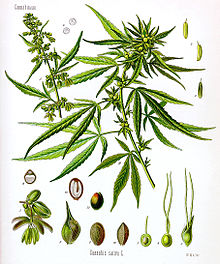




















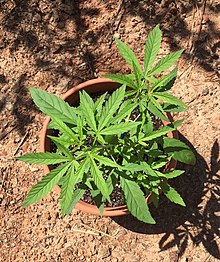




















 Clash Royale CLAN TAG
Clash Royale CLAN TAG